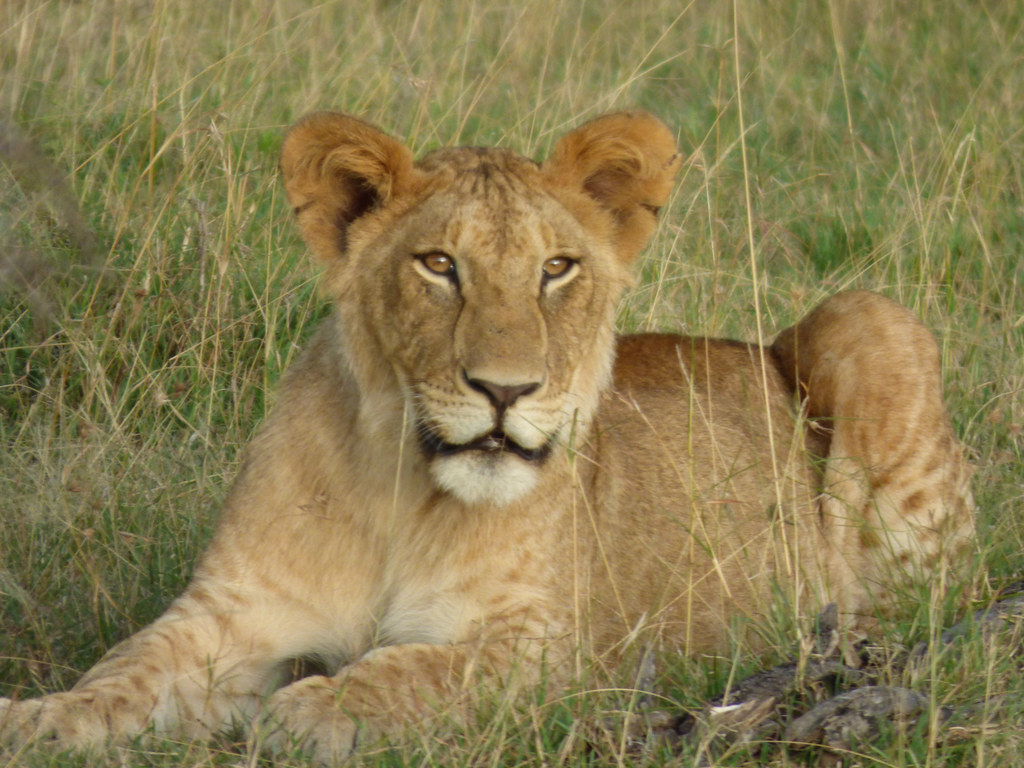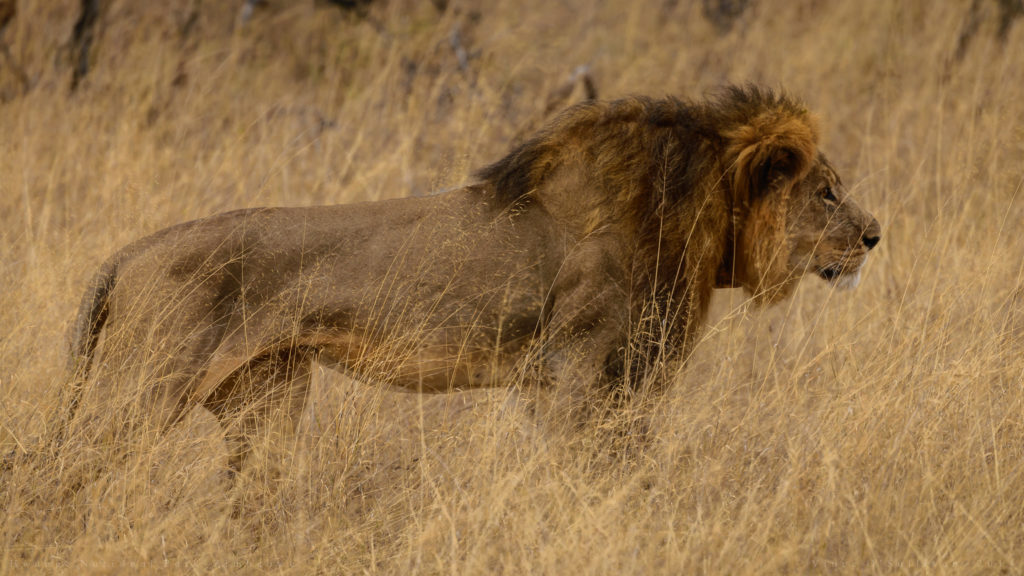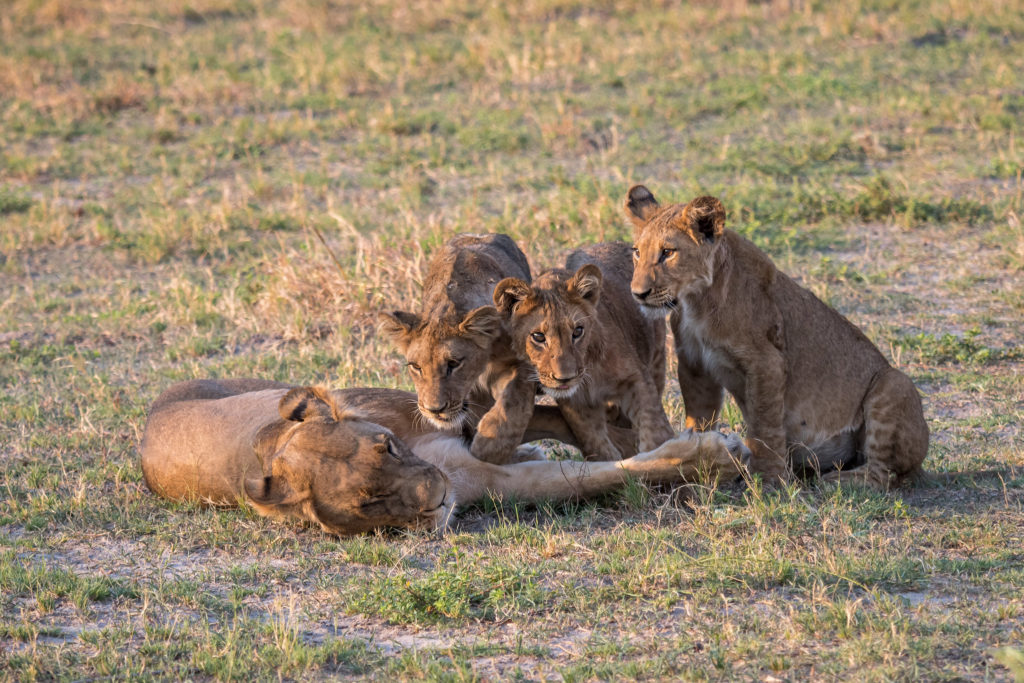Lions are perhaps the most iconic of wild animals. We love them and fear them, and most people have probably never imagined that we might be headed towards a world where they no longer exist in the wild. Unfortunately, even these fierce predators are threatened from many angles by human activities, and their numbers are in severe decline.
In her book When the Last Lion Roars, Sara Evans explores the complex story behind the lion’s precarious present. In an interview with Evans, we discussed her book, the threats lions face, and why we should have hope that these big cats will persist.
Dylan Forest: What inspired you to write this book, and what is the one biggest takeaway you hope readers will have?
Sara Evans: During my career as a travel and wildlife journalist, I’ve written about many animals, but it’s been encounters with lions that really captured my imagination and stayed with me. While travelling in Africa in the early 2000s, I was always lucky enough to see lions in most of countries I visited there. So, in 2012, it came as a shock to me learn that perhaps just 30,000 lions survived on the continent, compared to around 100,000 in the 1980s. That’s a huge decline in a relatively short amount of time. How could it be that lions, Africa’s most enduring icon, the very essence of invincibility and wildness, are slipping away, I wondered? And how could I let more people know about it? Answering these questions motivated me to write When The Last Lion Roars – to understand why lions, the king of the beasts, were vanishing and what could be done to prevent their ultimate extinction.
The biggest takeaway I hope readers will have is the desire to take action and help safeguard the future of wild lions; to be moved enough, to make a difference and help ensure lions don’t become one of the great but gone species we once shared the world with.
Your book takes a longer view of lion history than most alarm calls about their dwindling populations do. You trace the histories of since-disappeared lion empires that covered large swaths of Europe, the Middle East, and Asia. Some might use that history to say that lion populations have been changing and moving throughout history, and that what we see now is no different. How would you respond to this?

I would agree that yes, lion populations have been changing throughout history, generally downwards, but that in more recent times lion numbers have declined far more steeply and much more perilously. For example, in the 1880s estimates suggest that perhaps 1.2 million lions roamed Africa’s wildest places. Little more than a century on and around 100,000 were thought to be at large. Today, experts estimate there are fewer than 20,000 African lions. In the last 25 years, lion numbers in Africa have declined by half and in India only around 600 Asiatic lions survive, in total. Most of our lions are now missing and in some areas, are likely to become locally extinct in a handful of years. Lion numbers are now at crisis point; if they drop any lower, there may be no coming back.
Lion populations are dwindling to alarmingly low numbers. What are the biggest contributing factors in this decline, and what are the biggest obstacles we face in keeping them from going extinct entirely?
The biggest threat to lions is habitat loss. Because of unprecedented human population growth, land that was once lion country has been converted to agricultural use. As the number of people has rocketed, so too has the demand for crops and livestock – and, of course, the land to support them. Savannah in Africa has shrunk so dramatically that it is now more threatened than the world’s tropical rainforests. The lion’s des res is all but gone. In the last century, lions in Africa have lost more than three quarters of their territory.
Conflict between humans and lions is also a significant threat. As people settle in lion habitat, the distance between people and lions gets smaller. Almost inevitably, lions kill people’s cattle, goats, sheep – and even camels. And people, of course, take revenge by killing lions. Other threats to the big cats also come from people. This time from hunters and poachers, killing lions for bush meat and their bones. Poverty and inequality are big drivers behind illegal lion deaths.
Your book has two chapters titled “People Hate Lions.” This sentiment might surprise those of us who don’t live where lions do, and who think of lions as the king of beasts and one of the most iconic wild animal species. What makes you say that people hate lions, and why do you think this particular species has been such a target?
In the two chapters you mention, I look at the historic persecution of lions, in ancient, colonial and also more recent times, by people. I document that lions, in their thousands, have been hunted and taken from the wild, held captive, even publicly executed. I note, too, that lions are speared, shot and poisoned, their heads and bodies put on display. Some lions have been killed out of hatred because they have killed livestock or people. The actions of lions can cause people already in poverty to lose their livelihoods and the loss of family and friends is always painful.
Lions have also been killed to showcase a perceived superiority in the killer – to kill the king of the beasts, many have believed demonstrates supremacy over nature and other humans. There’s a certain hatred involved in this attitude too. Of course, and thankfully, not everyone hates lions and the two chapters that follow these are called “People Love Lions” and reveal that many people are doing all they can to prevent lions losing their lives. I wanted to use dramatic titles for these chapters to indicate the dramatic and often polar feelings lions can inspire in people.

Human-lion conflict is obviously a big problem in many areas where lions live. I was surprised to learn that not only do lions get themselves into trouble by killing livestock, but that lions killing humans is a problem in Ethiopia, Mozambique and Tanzania. This is especially sad because both problems are clearly a result of fewer food sources and shrinking habitats for lions, who are just trying to exist. But it also makes sense to me how loss of lives and livelihoods would inspire people to hate lions and want to get rid of them. Do you see a solution to this problem?
On this front, there is good news for lions. There are quite a few lion conservation initiatives that focus on reducing conflict between people and lions. These can work in a number of ways. A particularly successful approach is to make livestock bomas (enclosures) more robust against lion attacks and to use lights around bomas to deter lions. Community education can also help people learn how to protect themselves from lions, including sleeping indoors and setting up alert systems when lions are in the area. They are also schemes that compensate people for livestock taken by lions and others that provide people with an income based on the number of lions that people share the landscape with. This way, people associate lions with monetary value, which can be a good incentive for keeping lions alive.
One thing that struck me when reading this book is just how many threats there are against lions: trophy hunters, conflict with locals, the lion bone trade, disease, habitat loss, the list just seems to go on and on. In the face of all this it can look hopeless for lions. Even the title of your book seems to invoke extinction as inevitable. Are you able to find hope for lions’ survival?
The odds can seem stacked against lions, but there is definitely hope. In India, the population of Asiatic lions, although painfully small, is growing – up from 523 in 2015 to 650 in 2018. There, local people, wildlife organizations and government are successfully working together to protect and grow this endangered population. In East Africa, schemes like Lion Guardians, Lion Defenders and Wildlife Warriors are successfully helping local people live in harmony with their lions. In the south of the continent, lions are well protected and, in the main, are not at risk. Wildlife tourism, especially in South Africa, need lions to attract visitors and they will not let their populations be put at risk.
Elsewhere on the continent, there are lion conservation projects putting lions back into the landscapes they are extinct from. For example, in 2015, seven lions were translocated from South Africa to the Akagera National Park in Rwanda. Four years on, and there are now more than 16 lions in the Park. In 2018, in Malawi, nine lions were reintroduced into the Liwonde National Park where they were locally extinct, and 24 lions were locally reintroduced into the Zambesi Delta area of Mozambique where lions – because of poaching and the civil war – had been decimated.
The other factor that favors lions’ recovery is their resilience. With the right conditions, prides can recover quickly. And one of the best things for lions that Africa still has – for now, at least – is land. Africa retains a staggering 1.2 million square kilometers of protected habitat. If this can be kept intact and be properly protected, then it’s possible that by 2020 around 40,000 lions could be with us.

In terms of extinction, I imagine you have considered a world without lions, especially in light of everything you know. What are your thoughts on this possible outcome? What would be lost, and why must we do what we can to stop this from happening?
I don’t believe that we will lose all our wild lions. Lions are recovering in India and in southern and East Africa, lions will survive in national parks and other protected areas. In West and Central Africa, though, I fear that lions will vanish. Their populations are so fragile, so tiny and so remote that conservationists refer to them as the living dead. Their lives hang in the balance in some of the most populated and poorest areas on earth. Their loss will be significant, for as lion habitat vanishes, so does the other life that also depends on it. Disappearing lions are indicators of whole ecosystems under threat. When large mammals like lions reach the end of the line, countless other species join them, as they’ve lost their food sources and habitats too. All life is affected by the waning wild, not just lions: insects, amphibians, birds and mammals slip away too.
Thankfully, many people love lions and are working hard to try to save them. Can you share about a couple people or organizations who you think are doing the most impactful work to help lions?
Happily. Conservationists Leela Hazzah and Stephanie Dolrenry deserve a mention. They’re co-founders of Lion Guardians, a groundbreaking initiative that has helped Maasai communities in Kenya and Tanzania live peacefully with lions. As well as saving the lives of countless lions, Lion Guardians also provides education and employment opportunities for the local people that work with them.
Another organization making a difference to lions is African Parks. They work in some of Africa’s most challenging national parks, restoring habitats and wildlife in partnership with local people. African Parks is involved in lion conservation projects in west and central Africa and have been behind the reintroduction of lions in Rwanda and other countries on the continent.
Another important initiative is the Lion Recovery Fund, founded by the Wildlife Conservation Network and the Leonardo DiCaprio Foundation. They provide valuable funding to lion conservation projects that focus on protecting landscapes where lions live, enabling their prey to thrive, while also supporting local communities.
What would your advice be to the average person who wants to do something about the plight of lions?
I would suggest donating to any of the organization mentioned above. Also, once the Coronavirus epidemic is under control and we are free to travel again, to consider visiting one of the projects mentioned above.
Featured image: a male lion in profile. Image credit homegets.com, CC BY-SA 2.0.





